As you research phones for the office, you’ll come across a type of phone known as an IP phone. These devices are also known as SIP phones. SIP phones aren’t anything like analog-based antiques of the past — they work exclusively over the internet.
In this guide, we’ll explain exactly what a SIP phone is, how it works to make phone calls, and which models are likely to work best for you.
But first, let’s explain a couple of quick definitions and meanings around these IP phones.
What Is a SIP Phone?
A SIP phone is a device that uses the internet to make and receive phone calls. Instead of relying on traditional phone lines, SIP phones use a technology called Voice over IP (VoIP) to transmit voice data over the internet. This allows for several benefits over traditional phones, such as lower costs, advanced features, and wideband audio (HD voice).
There are two types of SIP phones: hardware and software.
- Hardware SIP phones: These are dedicated phone devices that look and feel like traditional phones. A hardware SIP phone is also known as a hard phone. These are familiar-looking desk phones that operate using IP telephony with a VoIP provider. Once authenticated, it stays connected to the service provider.
- Software SIP phones: These are software programs that can be installed on a computer or mobile phone. These applications are downloaded, often without any technical configuration. Users just sign in to their SIP service provider with their credentials, and they can begin receiving and making phone calls.
Examples of SIP applications are found in many communication products today.
SIP technology is found in conference phones, softphones, and even meeting software, which all use SIP protocol. Many organizations have moved towards retrofitting their IP PBX systems with SIP trunk providers to lower costs and add unlimited capacity.
What Is SIP?
SIP is short for Session Initiation Protocol, which is used to establish real-time voice, video, and messaging between two or more devices. It’s essentially the foundation of internet-based phone service, commonly known as VoIP.
Session Initiation Protocol (SIP) is a communication protocol that manages multimedia communication, such as video and voice calls. To use SIP, you need a SIP phone system that establishes communication over the internet.
Unlike traditional phone systems, SIP phones rely on Internet technology to make secure and reliable calls. The SIP protocol enables organizations to have unified communications, integrating basic phone capabilities with video, email, instant messaging, and more. Organizations use SIP phones if they want scalability, reliability, and unlimited voice calls.
Typical SIP Phone Features
SIP phones may resemble their predecessors, but their inner workings have substantially more functionality than traditional phones. Unlike their landline counterparts, SIP phones easily manage features like call hold, transfer to extensions, and even audio conference calling.
For IT professionals, the appeal lies in the simplified infrastructure. SIP phones connect directly to VoIP service providers, eliminating the need for additional hardware or server setups. This translates to lower maintenance costs compared to traditional phone systems.
Let’s look at the popular features of a SIP phone.
Top features of a SIP phone:
- Call forwarding: Never miss a call, even when you’re away from your desk. Forward calls to another number, voicemail, or even another phone simultaneously.
- On-hold music: Keep callers engaged (and not annoyed) with professional music or custom audio messages while they wait.
- Wi-Fi calling: Make and receive calls over any Wi-Fi network, freeing you from your desk and traditional phone lines.
- HD phone calls: Experience crystal-clear wideband audio quality for smoother, more productive conversations. ️
- Auto-attendant: Greet callers with a personalized greeting and direct them to the right person or department automatically.
- Call recording: Record business calls for reference, training, or quality assurance.
- Shared call appearance: Multiple phones can ring for the same incoming call, ensuring someone is always available to answer.
- Custom caller ID: Display your business name or specific department instead of just a phone number.
- Mobile and desktop app integration: Make and receive calls, manage contacts, and access other phone features directly from your mobile device or computer.
- Unified communications: Combine your phone system with other communication channels like email, instant messaging, and video conferencing for a seamless communication experience.
- HD audio: Enjoy wider audio bandwidth for richer, more natural-sounding conversations.
- Power over Ethernet (PoE): A PoE VoIP phone eliminates the need for separate power cables by powering your phone directly through your network cable.
Differences between VoIP vs. SIP
While often used interchangeably, Voice over Internet Protocol (VoIP) and Session Initiation Protocol (SIP) play distinct roles in business communications.
VoIP forms the technological backbone, enabling voice communication to travel over broadband connections instead of traditional phone lines. It digitizes voice data, resulting in clearer call quality and opening doors to features like video conferencing and call recording. With a VoIP provider, calls can connect between the public switched telephone network (PSTN).
SIP, on the other hand, acts as a standardized language. It dictates how devices and platforms initiate, manage, and terminate communication sessions between users. By establishing a common set of rules, SIP ensures seamless interoperability between diverse VoIP systems, allowing calls to flow smoothly across different devices and platforms.
In essence, VoIP provides the calling technology, while SIP acts as the standardized communication protocol that makes it all work seamlessly. While VoIP can function without SIP, incorporating this universally accepted language maximizes compatibility and ensures a smooth communication experience.
Types of SIP phones
SIP phones generally fall into two categories: hard phones and softphones. SIP phones can only work with cloud-based phone systems, unlike traditional analog phones.
Hard Phones (IP desk phones and conference phones)
A hard phone looks like a regular telephone and, indeed, behaves like one. Hard phones connect using Ethernet cables and can come in a cordless form. Popular SIP hard phones include Poly, Cisco, Nextiva, and Panasonic. Most of these desk phones offer similar features, with a few differences between them.

Not all hard phones are the same. They are classified into basic, intermediate, and advanced categories.
- Basic: Considered almost a starter VoIP phone, these SIP phones are what you might see used by call center or contact center staff. These phones have a dial pad and can complete internal and external phone calls. These hard phones are budget-friendly and are very easy to use.
- Intermediate: A step up from basic, intermediate SIP hard phones provide more robust functionality, often including a browsable directory with multiple extensions. Physically, these phones might have a few more buttons for extra VoIP features. These phones are often deployed across the workforce, even sent with employees if they work from home.
- Advanced: Advanced SIP hard phones can do anything a basic or intermediate phone can do and often feature a full-color display, multiple extensions, Wi-Fi, or Bluetooth compatibility. Visually, these phones look more refined and are enjoyed by company executives. These phones may have fewer physical buttons because applications can be accessed through the display.
One limitation of hard phones is that they are stationary. Over half of the United States workforce is predicted to work remotely over the coming years, and businesses are looking into low-cost alternatives for desk phones. This is where softphones come into play.
Softphones (VoIP apps & contact center software)
Softphones are applications that provide users with phone service connectivity through software installed on a desktop, laptop, or smartphone. Once your VoIP app is installed, use a headset and microphone for the best calling experience.
A softphone may be installed by administrators or by users in a self-service format. IT leaders who are considering using softphone technology need to think about their network utilization. SIP traffic from softphones can’t be easily singled out compared to other network applications. For those with a mandatory VPN, you will want to complete a VoIP line test to evaluate the health of your connection.

With VoIP, call quality adapts to changing network conditions automatically, such as limited network bandwidth. For frequent softphone users, they might experience shorter battery life on their cell phones. These factors mean that IT leaders have to plan before deploying softphone apps to their employees.
How SIP-based telephony works
Session Initiation Protocol-based telephony employs straightforward commands akin to those used to access web pages. The analog signals from the handset are digitized and transmitted as data packets through the network to the call recipient.

SIP phones connect to servers, which initiate contacts with other extensions or route calls. When a call connects, the server and phones negotiate call quality and codecs in real time. Here’s a technical overview broken down into six steps.
How SIP calls work
SIP calling functions through a series of digital handshakes. From the initial dial to the final hang-up, SIP messages orchestrate the entire call process. The following points outline the typical steps involved in how SIP calling is established and maintained:
- A user picks up the handset of a SIP phone and dials a number to place a call.
- The SIP phone sends a SIP “invite” message to the SIP server it is registered with. This message indicates that the user wants to initiate a call.
- The SIP server processes the invite request. It may connect the call to another extension registered to the same SIP server, or it may route the call out over the Public Switched Telephone Network to connect the party.
- Once the dialed party answers, the two SIP phones exchange information to set up two-way audio transmission. They agree on which codecs and bandwidth to use.
- As the call progresses, the phones continue to send SIP signaling messages to provide status updates and ensure quality. For example, if packet loss occurs, a phone may request a codec with lower bandwidth requirements.
- When one party hangs up, a SIP “bye” message is sent to terminate the call on both sides and disconnect the media session.

The good news here is that nearly all users and most IT administrators won’t ever need to deal with any of the minutiae of the SIP protocol. With a reliable business VoIP platform like Nextiva, you’ll focus on assigning virtual phone numbers and extensions to users and adjusting settings.
Benefits of SIP phones
It can be very cost-effective to upgrade to SIP phones, no matter the size of your company. Overall, there are several advantages to using SIP phones.
- You won’t depend on your local telephone company for copper lines.
- No maintenance or additional configuration unless you want to.
- Connect all employees within the business, including remote teams.
- Take advantage of call encryption for increased data security.
- Cloud-based management of your phone system means instant delivery of features anytime.
Your main use for SIP phones should be identified more than the brand of SIP phone you select. Think through the real-world examples of how your employees use their phones to communicate.
Some employees need more powerful phones, like a busy receptionist or a prominent business executive. Even for small businesses, there’s an affordable SIP phone that will help your team communicate more effectively.
Top-Rated Business SIP Phones
To help you through your next telephony technology investment, we have put together a quick comparison guide of the top SIP phones available on the market today. Just a few notes to keep in mind:
- Mix and match them to your employee’s needs
- Support and configuration are often included from a SIP provider
- You have the option of purchasing or leasing (renting)
Basic SIP Phones
Poly Edge E220
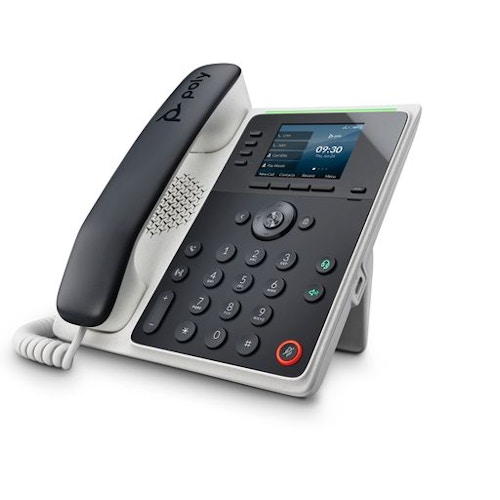
The Poly Edge E220 phone will keep you sounding professional. This SIP phone pairs the famous Poly noise-blocking technology with a cutting-edge design that brings style to any desktop or reception area. The Poly Edge E220 phone is always on, easy to use, secure, reliable, and stable. Priced at $160.
- Number of Lines: 4
- Display Type: Color LCD
- Screen Size: 2.8″
- POE Available: Yes
- Bluetooth: Yes
- Wi-Fi: No
- USB port: 1 USB Type C
Yealink T33G
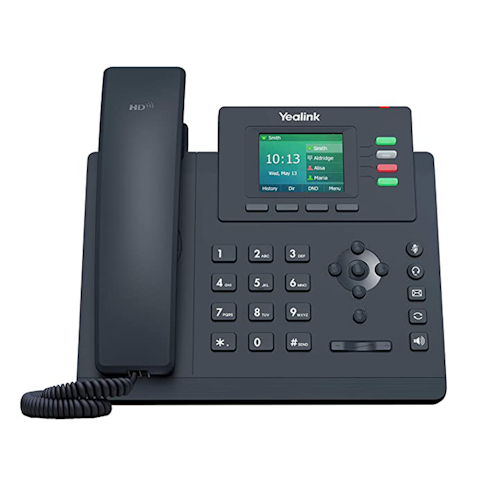
An entry-level color screen IP phone with high performance, the Yealink SIP-T33G offers support for four lines. For its fashionable appearance as well as a 320×240-pixel color display with backlight, it brings a comfortable operation experience and a clear visual experience for users. Priced at $100.
- Number of Lines: 4
- Display Type: Color
- Screen Size: 2.4″
- POE Available: Yes
- Headset Input: RJ-9/EHS
Intermediate SIP Phones
Nextiva X-815
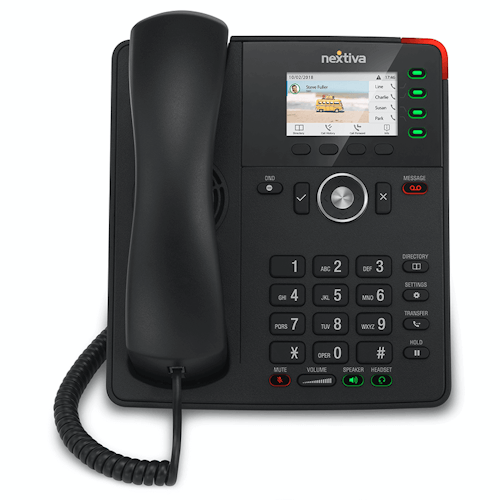
The Nextiva X-815 is a sleek, six-line, color, SIP phone ideal for call center or office workers. The phone’s interface is clean and well-organized, so you’ll handle calls with greater ease and confidence. Priced at $130.
- Number of Lines: 4
- Display Type: Color LCD
- Screen Size: 2.8″
- POE Available: Yes
- Gig Ethernet Ports: Yes
- Wi-Fi: Yes, USB A210 Adapter Required (sold separately)
- Speed Dialing: Yes
- Headset Input: RJ-9
- USB port: 1
Poly VVX 350
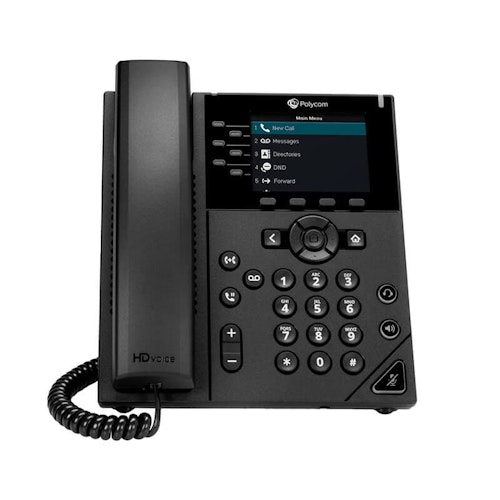
A high-quality, six-line, color, mid-range, SIP phone ideal for call center operators who handle moderate/high volume of calls, and for small teams to know which team members are on the phone. Priced at $220.
- Number of Lines: 6 native lines (24 with pagination)
- Display Type: Color LCD
- Screen Size: 3.5″
- PoE Available: Yes
- Headset Input: RJ-9
- USB ports: 2
- Bluetooth/Wi-Fi: Yes, both via dongle
- Warranty: 1 year; lifetime when rented
Advanced SIP Phones
Nextiva X-885

A sleek, twelve-line, color, SIP desk phone ideal for executives and receptionists. It has a multi-page approach to provide twelve additional programmable keys. It comes preconfigured out of the box for Nextiva’s business phone system.
- Number of Lines: 12
- Display Type: Color LCD
- Screen Size: 4.3″
- PoE Available: Yes
- Gig Ethernet Ports: Yes
- USB port: 1
- HD Voice: Yes
Cisco IP Phone 8865
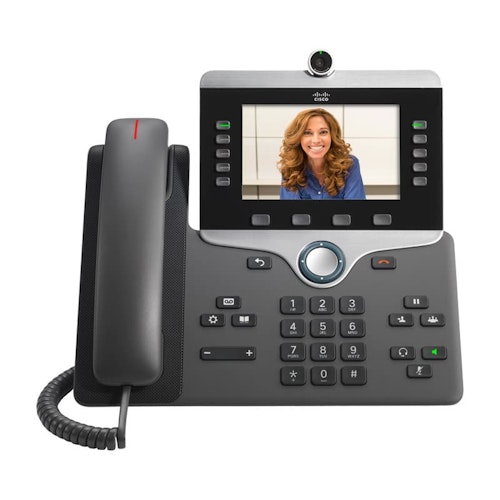
The Cisco IP Phone 8865 is a premium enterprise SIP phone designed for executives and managers. It features a large color touchscreen display, Bluetooth support, wired and wireless headset options, a handset, integrated Wi-Fi and Ethernet ports, and up to 10 business phone lines. The high-resolution 5-inch touchscreen enables rich visual communication, while the wideband audio with HD Voice delivers crisp, clear sound quality. Priced at $350.
- Number of Lines: 10
- Display Type: Color LCD
- Screen Size: 5″
- POE Available: Yes
- Gig Ethernet Ports: Yes
- Speed Dialing: Yes
- Bluetooth: Yes
- Wi-Fi calling: Yes
- HD Voice: Yes
- USB ports: 2
- Expansion Module Connectivity: up to 3
- Headset Input: RJ-9
How to Get a Business Phone Number
The process of getting a phone number for your SIP phone begins by signing up with a VoIP provider. You have the option of using your existing phone numbers through a process known as porting. While porting may take a couple of weeks to complete, you can use a virtual number right away.
Since every SIP phone has a hardware ID assigned, it looks to the service provider to know which numbers it can use. You or your phone service provider can associate SIP phones with any desired phone number that you authorize.
With the Nextiva VoIP platform, your SIP phone comes configured out of the box. Plug it in, and you can begin taking phone calls right away.
Choosing Your SIP Phone Service Provider
As you decide on the equipment you need for your company’s communications needs, consider these best practices.
- Evaluate the service provider first, then the SIP phone. Your company’s experience is most influenced and shaped by the service provider, especially customer service.
- Research the company’s network infrastructure. A cloud phone system has multiple points of presence, known as POPs, around your continent for maximum reliability.
- Plan your needs 18–24 months out. You might have modest needs today, but they will surely expand as your company grows. Create the working environment you want now so there is no chaos later. Plus, you can maximize your cost savings.
Last but certainly not least is the quality of support you have available. Is your VoIP provider available at 9 p.m.? How fast do they answer the phone at 10 a.m.? When it comes to your business, you can’t let life pass you by while waiting on hold.
Now that you’ve researched everything about SIP phones, why not check out the VoIP phones we have available? Our team thoroughly tests and supports every device to confirm it meets your business needs.
FAQs
SIP phones are the devices you use to make and receive calls, like cordless phones, but powered by your internet connection. They connect to a SIP service provider who manages the call routing.
SIP trunking is a service itself, acting like a bridge between your business’s IP PBX system and the PSTN (traditional phone network). It allows your existing IP PBX to make and receive calls through the internet, without needing separate phone lines.
SIP phones and VoIP phones are related technologies with a key distinction. VoIP is the broader technology that enables voice communication over the internet instead of traditional phone lines. SIP, meanwhile, is a specific protocol used within VoIP systems to establish, modify, and terminate multimedia sessions, including voice calls.
VoIP is the general concept of internet-based calling, while SIP calling is one standardized method to implement it. All SIP phones are VoIP phones, but not all VoIP phones use the SIP protocol — some use proprietary protocols like Skype or other standards. SIP phones offer advantages, including interoperability between different providers, easy scalability, and integration with other communication tools.
A SIP phone service provider is the backbone of your SIP phone system. They provide the infrastructure and software needed to route calls, manage phone numbers, and offer additional features like voicemail, call recording, and conferencing. Primarily, they establish calls between the public telephone network and your internal office phone system.
Consider factors like call quality, pricing, reliability, and desired features. Research and compare to find the best fit for your business needs.
Follow these tips to ensure your SIP phone system delivers reliable and clear communication.
– Use high-speed internet: Maintain a consistent and reliable internet connection to avoid call drops and choppy audio.
– Use quality equipment: Invest in good-quality SIP phones and network hardware from trusted vendors to minimize technical issues.
– Monitor performance: Track call quality metrics and diagnose any recurring issues early.
– Set up Quality of Service (QoS): Tune your network to prioritize voice traffic so it doesn’t get congested when users share or stream video over the internet.

















 VoIP
VoIP 










